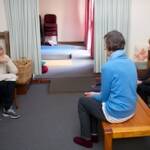How Does a Retreat Work?
Silence, Space, Understanding and Be-Friending Oneself

A retreat provides an opportunity and a safe space for exploring meditation and the workings of one’s own mind and body. The central practice is always mindfulness, which allows us to see clearly the difficulties we create for ourselves and how to let go of old habits which undermine our freedom and peace of heart and mind. Retreats usually also include some training in loving kindness meditation to help us develop greater compassion and understanding for ourselves and others.
Retreat groups at Vejjasala are not more than 25 people. After the first evening of the retreat, the rest of the retreat will most likely be held in silence. Retreatants do not speak to each other unless absolutely necessary. In silence, retreatants can better stay with their own experience, moment by moment. In this way, awareness increases, the body relaxes and the mind clears and space opens for understanding and insight to develop.
As awareness grows we see that our lives can be driven by our unconscious fears and desires or we can choose to live with clarity, kindness and understanding. By cultivating clear understanding and kindness we discover the way to inner freedom and a peaceful heart.
Retreat Schedule

The first session of the day usually begins about 6 am and there will be a wake-up bell in the main house about half an hour before the session begins. You are welcome to get a cup of tea before the session. Following the first meditation session there will often be a short yoga practice before breakfast. Following breakfast, there is some free time, and some participants will assist in clearing the breakfast things while others may take the opportunity for a walk in the bush.
The meditation practice will resume around 10am and the rest of the day and evening will be taken up with sessions of sitting and walking meditation, mindfulness work tasks, and Dhamma talks. There is usually some free time after lunch for bush walking or resting. The whole retreat is a succession of different mindfulness practices, including awareness of the breath and the body, the natural environment, the nature of our minds and our feelings.
Forms of Mindfulness that you might encounter at a retreat
Sitting Meditation: Sitting meditation will be at the heart of most retreats. As we sit in silence, a deep relaxation takes place and awareness of body and mind deepen. Using awareness of the breath as our primary focus, we develop greater concentration and as calm and steadiness are established the meditation may be opened to include mindfulness of thoughts, emotions and the nature of the mind itself.
Walking Meditation: Walking gracefully and gratefully on the earth is also one of the great Buddhist meditative practices. On retreat, periods of walking meditation alternate with periods of sitting meditation. In walking meditation, mindfulness is cultivated by resting the attention on the sensations in the body as one walks. Thus in walking meditation we become aware in the midst of activity. Throughout the retreat we learn to cultivate a mindful awareness in all postures prescribed by the Buddha – sitting, walking, standing up or lying down.
Eating Meditation: Food is an essential part of our lives and in the retreat mindful eating is encouraged. We can be aware of the sensations of eating in the body and our mental response to the food. The act of eating the food that is offered connects us to all of those beings who grew the food and delivered it to us, reminding us of the interconnectedness of all beings. On retreat, carefully prepared vegetarian meals are served. The most substantial meal is served at mid-day. The lightest meal of the day is the “evening meal” usually offered around 6.00 pm.
Work Meditation: In a mindfulness retreat, work meditation is an important part of the retreat practice. Through it we learn how to bring mindfulness to the everyday activities of our life. Work meditation also supports the community and ensures the smooth running of the retreat. On the first evening, retreatants are offered a selection of work assignments to choose from for the course of the retreat (such as helping in the kitchen during preparation of meals, cleaning up afterwards, participating in the clean-up of the centre at the end of the retreat). The daily completion of your task is part of the continuous cultivation of mindfulness.
Yoga: For many people the physical practice of yoga offers an ideal way to transition from daily activities into sitting meditation. It provides structured sequences of movement that make it easy to focus on sensations in the body and the state of the breath. The stretching helps to relieve tightness and tension in the body which may result from long periods of sitting and over time the postures strengthen the body to make sitting easier. As Patanjali once said, “We come to yoga to develop our capacity for meditation and to lessen our afflictions.” Yoga may be offered before breakfast and sometimes there is an afternoon session as well. Yoga sessions are optional – please consult the teacher beforehand if you have concerns about your ability to do the practice.

